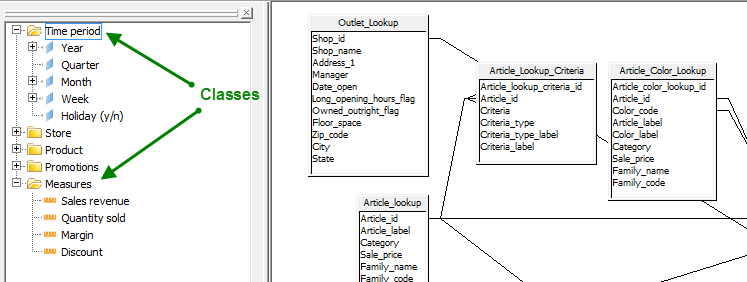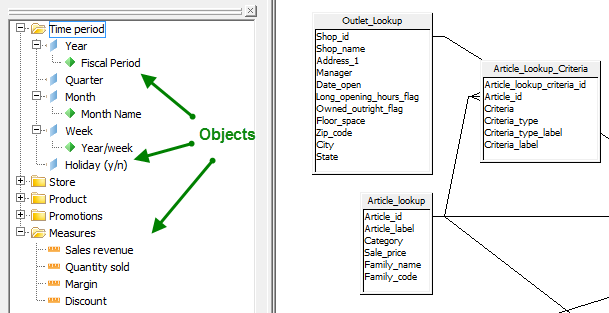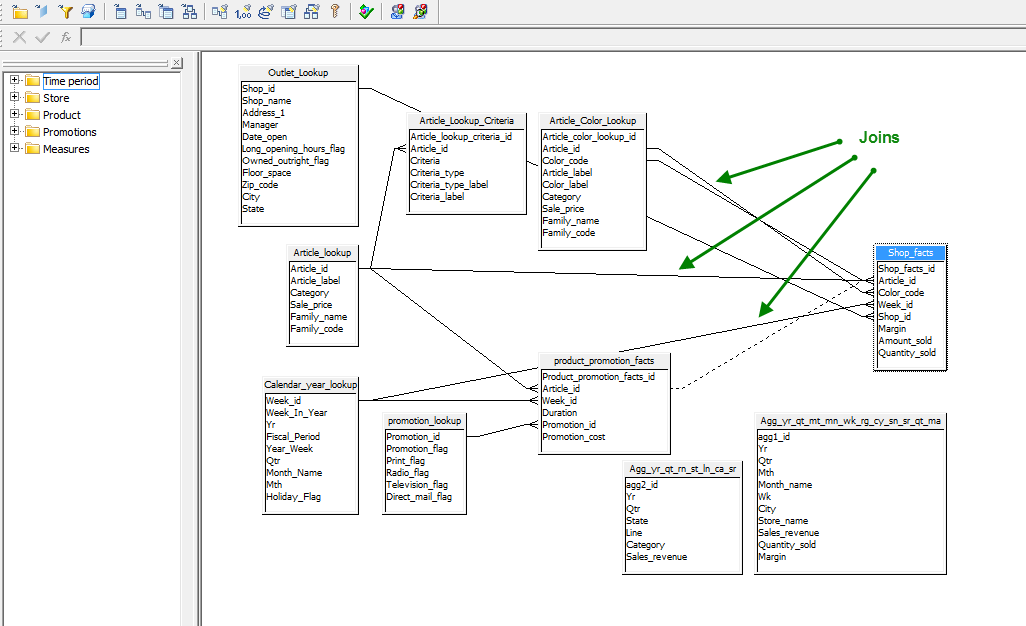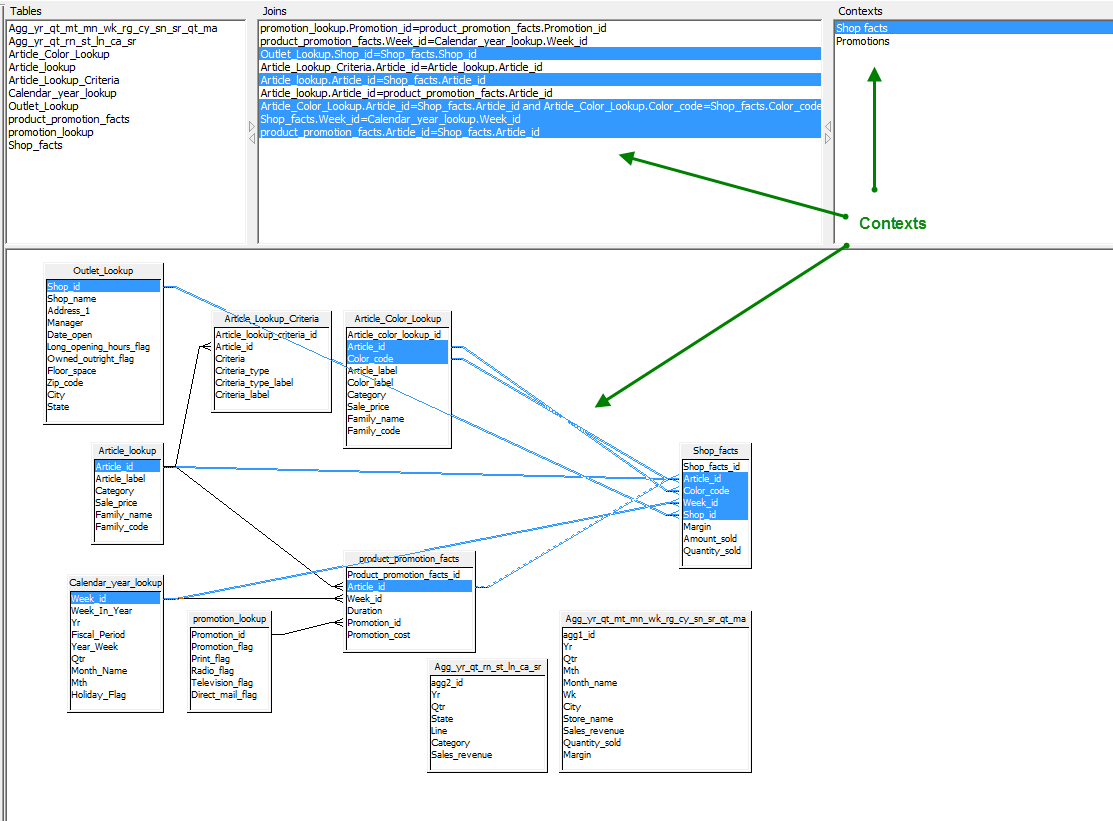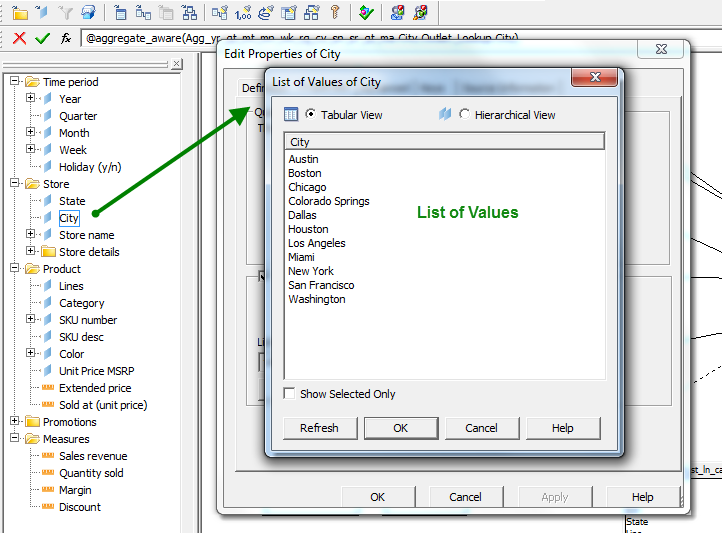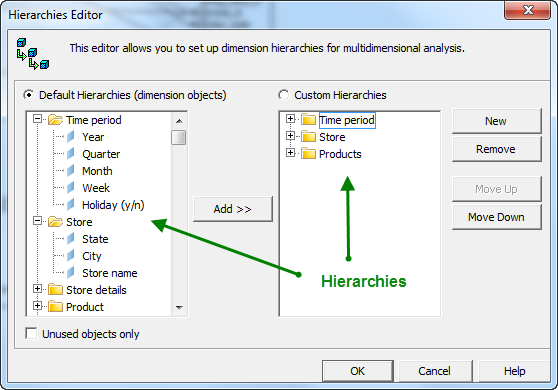
Also known as a “semantic layer”, the Business Objects Universe is an intermediary layer between a database or data source and dependent reports, queries, or dashboards. Fundamentally, the universe enables the end-user of Business Objects to interact with data without having to understand the complexities of database logic or be familiar with where the physical data is stored. Moreover, the universe is built around common business terminology that describes the business environment and provides the end-user the ability to intuitively query and retrieve exactly the data that they need.
- Fundamentally a Business Objects Universe is a file that contains:
- • Connection information to a database
- • Components that map to structures in the database
- • A structure and layout of classes, objects, tables, views, joins, and contexts.
Universe Component: Class
Groupings or categories of objects within a universe are called classes. The primary function of classes is to provide structure to the layout of universe. Typically, the general strategy is to group related dimension and detail fields into a class and place measure objects into a different class. This strategy can be extended through introducing sub-classes to break down objects into more granular subsets.
- Three categories of classes exist …
- • Dimension Classes: Objects which are shared across transaction types to describe the transaction and provide summarization levels.
- • Measure Classes: Primary reporting objects for displaying numeric results (also known as facts).
- • Application Classes: Objects that support the reporting application, including customized lists of values, prompts, and condition objects.
Universe Component: Object
Objects refer to fields or columns within database tables or views. Properties of an object include a name, data-type, select statement, and sometimes a where statement. Objects can refer to a single database field or can be an expression of one or multiple database fields.
- Three type of objects exist within a Business Objects universe …
- • Dimension: Text based or date values that are the primary describing values of a query.
- • Detail: Text based values that provides detailed information of a dimension. A detail is always attached to a dimension.
- • Measure: Numerical values that are the results of a query and by which dimensions are compared.
Universe Component: Table
Tables refer to individual physical tables, views, or synonyms within a database that provide data to the universe. Further, a universe represents a set of underlying tables. Universe tables in Business Objects do not actually replicate any data from the underlying database tables and no data is stored in the universe itself.. Rather universe tables are pointers to fields in the database and universe tables let Business Objects know where to find the data in the underlying database.
- In a data warehouse or data mart environment, primarily used for reporting and analytics, there exists two types of tables: 1) dimension tables and 2) fact tables. Dimension tables can descriptive values such as customer, product, date, or location. While fact tables contains numeric information that will be calculated in a query.
Universe Component: Join
- Joins specify the characteristics of how tables, views, synonyms, or aliases relate to one another. In addition, joins allow the universe to combine information from multiple tables. A join is a condition that restricts the result set of a multi-table query.
There are four types of joins available in a universe …
- • Equi-join (also known as inner join): A join based on column values in a column between two tables.
- • Outer join (also known as right and left joins): A join that links two tables, one of which has rows that do not match those in the common column of the other table.
- • Theta join: A join that links tables based on the relationship other than equality between two columns. Typically used to select records between a set of values.
- • Self-Restricting join – A method used to set a restriction on a table in the universe structure. In essence it is a where condition created by a join property.
Universe Component: Context
- A context is a group of tables and joins that define a specific path for a query and resolve loops that may occur within queries. Contexts are used to specify alternative routes and ensure that a single select statement only includes reference to columns from tables in one of those routes. In essence, a context is a rule by which the the report user can decide which path to choose when more than one join path exists in query from one table to another table. Without contexts, queries could contain multiple paths (also known as loops). And loops generally result in incorrect queries with fewer rows returned than expected. However, contexts make sure that there are clearly defined paths between tables and that no loops exist within a universe.
Universe Component: Alias
- An alias is an exact duplicate of a universe table but with a different name. The data in the table is exactly the same as the original table, but the different name allows the universe to accept the same table into its structure and identify the referenced instance of the table. A common use of alias is when a lookup table needs to be referenced several times in a query and when different join rules exist for the lookup table. The alias allows for the lookup table to be included multiple times in a universe and allows for the correct join rules to be associated with the lookup table.
Universe Component: List of Values
- A list of values is a data list with a universe object that contains the data values associated with that particular object. A list of values can contain data from two types of data sources: 1) database tables 2) external file sources. List of values contain a number of values that define how the data is presented in the list and define restrictions on the amount and type of data returned to the list.
Universe Component: Hierarchy
- Hierarchy is an ordered sequence of dimensions which allow the users of Web Intelligence and Desktop Intelligence to perform multidimensional analysis on the data. In addition, hierarchies allow the user to observe data from various perspectives and hierarchies are critical in spotting trends or exceptions in the data. By default hierarchies are set based upon the order in which dimensions are placed in a class. However, universes also allow creation of custom hierarchies in which the sequence of dimensions is defined by developer based upon the business need. In essence, hierarchies allow for drilling of data.
There are four types of drilling capabilities available in Business Objects …
- • Drill-Down: Displaying data at progressively more detailed level.
- • Drill-Up: Displaying data at a less detailed level or a higher summery level.
- • Drill-Through: Provides the ability to query the database directly and get the data at lower level than the lowest level in the hierarchy.
- • Drill-By: Displaying data at a particular level in the hierarchy without having to visit each level in turn.

